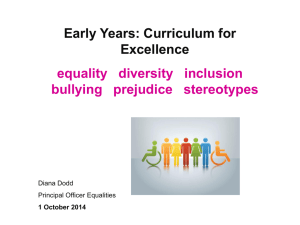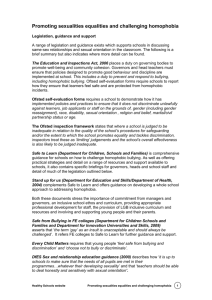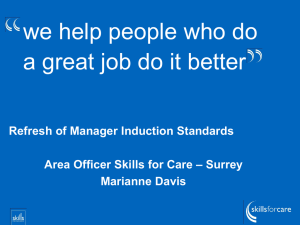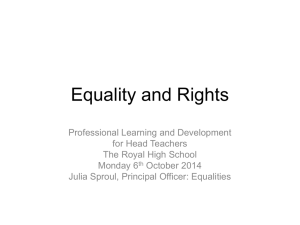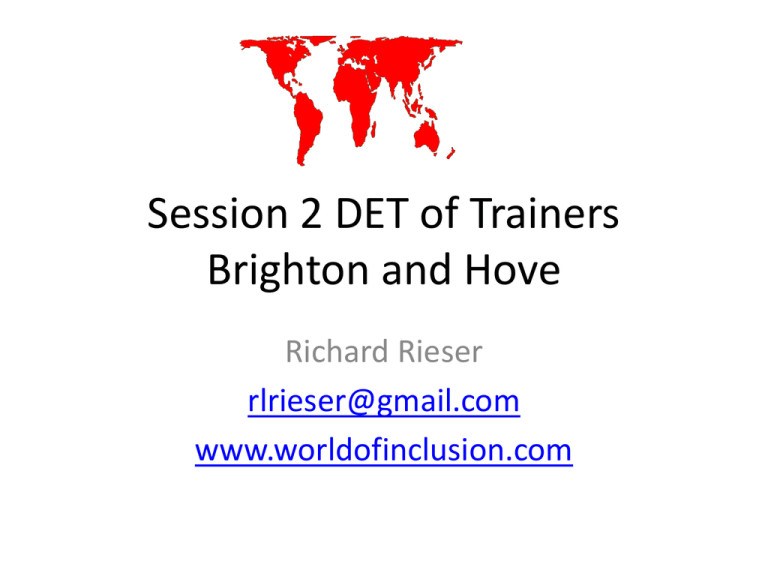
Session 2 DET of Trainers
Brighton and Hove
Richard Rieser
rlrieser@gmail.com
www.worldofinclusion.com
Use a Line to Match the Areas of School Policy and Practice to Disability Equality Objectives in Sc
1.
Assessment 20
1.Impairment based name calling challenged and recorded.
2.
Discipline 18
2.School Access Plan progressively realised.
3.
Pupil Participation 6
3.Fund earmarked for auxiliary aids and services.
4.
Anti-Bullying 1
4.Menus checked for allergens, different diets catered.
5.
Capital-Funding 2
5.Positive action exercised to increase number of disabled staff in all
grades.
6.
Staff-Employment 5
6.EnsureYear and School Council has disabled representatives.
7.
Curriculum 17
7.All venues and activities offered checked for access and barriers.
8.
Teaching and Learning 11
8.Governors are aware of duties under Equalities Act and implement
9.
School Meals 4
9.A variety of books age appropriate that are easy read.
10 . After School Activities
19
10.Fire Practice evacuates all students/Signage accessible.
11. Trips and Outings 7
11.All teachers take responsibility for the learning of all class pupils.
12.
Governance 8
12.There are a variety of appropriate software and access methods.
13.
Premises 10
13.Equalities Objectives include disability and are monitored.
14.
Library 9
14.All learners are welcomed and different provision explained.
15.
ICT 12
15.Class furniture and fittings flexible & adjustable for range need.
16.
17.
18.
School Revenue Budget 3
Equalities Objectives 13
16.Senior Managers promote inclusion and progress of all
17.Disability is positively approached in all study areas.
Information for Parents 14 18.There is an agreed differentiated Behaviour Policy.
19.
Classroom layout
20.
Management
15
16
19.Provision is made to support disabled pupils/students
20.Additional time, amanuensis and different formats available
Set and Review Values of Organisation in light of
Disability Equality Duty: Index for Inclusion
• Valuing all students and staff equally.
• Increasing the participation of students in, and reducing their exclusion from,
the cultures, curricula and communities of local schools.
• Restructuring the cultures, policies and practices in schools so that they
respond to the diversity of students in the locality.
• Reducing barriers to learning and participation for all students, not only those
with impairments or those who are categorised as `having special educational
needs'.
• Learning from attempts to overcome barriers to the access and participation of
particular students to make changes for the benefit of students more widely.
• Viewing the difference between students as resources to support learning,
rather than as problems to be overcome.
• Acknowledging the right of students to an education in their locality.
• Improving schools for staff as well as for students.
• Emphasising the role of schools in building community and developing values,
as well as in increasing achievement.
• Fostering mutually sustaining relationships between schools and communities.
• Recognising that inclusion in education is one aspect of inclusion in society.
• http://www.csie.org.uk/resources/inclusion-index-explained.shtml
The Bicycle all process move in same direction
guided by Equality and Value for Money
Procurement
Outcomes
Impact on Procurement of School or Local Authority
• Within your procurement activities, consider whether or not your
school,authority’s overall corporate vision and aims supports
• compliance with the equality duty
adding value by achieving wider corporate equality aims
• Are relevant equality matters and the requirements of the
equality duty addressed in your procurement /commissioning
strategy?
What steps can you take to improve your performance?
Why are so few children with disabilities accessing and completing
basic education? Finding from the UNICEF REAP Project 1.
• Generalised approaches of the inclusion of all
excluded groups are not sufficient. Education
for All and Millennium Development Goal 2
have talked of All, without the specifics of the
training and accommodation of meeting
different impairment needs.
• Reactions to categorical medical model/deficit
SEN approaches has led to its replacement
with generalised inclusion principles
Why are so few children with disabilities accessing and
completing basic education? 2.
• This leaves most teachers believing that the
expertise for, and the inclusion of, children with
disabilities, is someone else’s expertise and
responsibility.
• What is needed is twin track approach, with
mandatory training, for all teachers on how to
meet impairment specific needs, as well as,
more general training on developing child
friendly classrooms for all. Backed up by
disability specialist local resource centres and
teachers.
Track One Education based on Principles of
Equality and Child Empowerment.
•
•
•
•
•
•
•
•
Equality and Valuing Difference
Identifying Barriers-Finding Solutions
Collaborative Learning -Peer Support
Differentiation & Flexible Curriculum and
Assessment and monitoring
Stimulating and Interesting Multi-Sensory
Learning Environment
Anti Bias Curriculum-Disability Equality Training
Child Centred Pedagogy, Creative with Reflective
Teachers
Quality education requiring rigour and effort for
each child to achieve their potential
Track Two Education accommodating the different
impairment specific needs of children with disabilities.
Blind And Visually Impaired
Braille, Tactile Maps
Tapes and Text to Talk,
Mobility Training,
Large Print, Magnification,
Orientation,
Auditory Environment &
Talking instruments
Deaf Blind
Language,
Interpreters,
Tactile
Environment,
Orientation
Deaf & Hearing
Impaired
Sign Language
Taught &
Interpretation,
Oral/Finger Spelling,
Hearing Aid Support,
Visual Environments
Physical
Impairment
Accessible Infrastructure.
Toilets, Furniture
Equipment,
prosthesis,
Personal Assistance
Diet, Transport,
Medication.
Speech &
Communication
Facilitated
Communication
Augmented
Communication
Switching,
Talkers,
Information
Grids.
Specific Learning
Difficulty
Colour overlays &
background
Easy Read
Tapes and Text to Talk
Spell- checker
Concrete objects
Mental Health and
Behaviour
Counselling and
Personal support,
Differentiated
Behaviour Policy,
Empathy
Quiet /chill out space,
Circle of Friends,
Differentiated
Behaviour Policy,
Structured Day.
General Cognitive
Impairment
Pictograms, Small Steps
Curriculum, Easy Read,
Scaffolding, Makaton,
Symbols, Info. Grids,
Concrete objects
Screening, identification and key adjustments for main impairments
What is Inclusive Education ?
“Inclusive Education refers to the educational practice base on
the philosophical belief that all learners, those with
disabilities and those without, have a right to be educated
together in age appropriate class groups, and that all will
benefit from education in regular classrooms of community
schools. Within these settings teachers, parents and others
work collaboratively using appropriate and sufficient
resources to interpret and enact the regular curriculum in a
flexible manner in accordance with the individual abilities
and needs of all learners.” Prof Gary Bunch Ontario
Exclusion
?
Segregation
THE CONTINUUM OF PROVISION
SCHOOL WITH OWN
RESOURCES
SCHOOL WITH EXTRA
RESOURCES FROM LEA
SPRECIAL UNIT ATTACHED TO
MAINSTREAM
SPECIAL DAY SCHOOL
INDEPENDENT SCHOOL
(LEA funded)
SPECIAL RESIDENTIAL
SCHOOL (weekly or full
boarding, up to 52 weeks a year)
line of
invisibility
The geographic
expression of the
medical model in
education.
Move from seeing impairment and
label as determining no school or
special school to schools and
teachers which are flexible and
where the support they need is
brought to the child.
SECURE UNITS
The Constellation of Services
Develop child centred approach.
Teacher trained in inclusion.
Buildings and learning materials
accessible.
Specialist advise and support.
Curriculum flexible.
Peer support.
Community educated for inclusion.
Special schools become resource
centres.
Transport
Department
Individual
Support
Teacher
SENCO
Aids Advisor
CHILD
Learning
Support Assistant
Parents
Head teacher
Educational
Psychologist
Friends
Brothers
and Sisters
Visually
Impaired
service
Voluntary
Sector Specialists
LEA Inclusion
Officers
TEACHER
Speech
Therapist
Physiotherapist
Volunteers
Behaviour
Support Team
Hearing
Impaired
Service
Environment
Find Barriers and then
After film Solutions
Organisation,
Teaching &Curriculum
Attitudes & Culture
School
Medical, Personal &
Equipment Needs
The principles of school inspection as described in
the ‘Framework for School Inspection’, Sept. 2012
•
“that the inspection will focus on the needs of pupils and parents by
evaluating the extent to which schools provide an inclusive environment
which meets the needs of all pupils irrespective of age, disability, gender
reassignment, race, religion or belief, sex or sexual orientation. The
‘Ofsted School Inspection Handbook’, September 2012 states that
inspectors will request logs of racist incidents and incidents of bullying,
including homophobic bullying. Under the Behaviour and Safety
judgement of the Ofsted Evaluation Schedule inspectors are asked to
consider:
• types, rates and patterns of bullying and the effectiveness of the school’s
actions to prevent and tackle all forms of bullying and harassment – this
includes cyber-bullying and prejudice-based bullying related to special
educational need, sexual orientation, sex, race, religion and belief,
gender reassignment or disability
• the effectiveness of the school’s actions to prevent and tackle
discriminatory and derogatory language – this includes homophobic and
racist language, and language that is derogatory about disabled people.
Bullying Brighton and Hove 20112-July
2013
Appe Dis/SE Home
arenc N/Me Circ.
e
dical
Gende Race
Religi Sex
r Id.
Ethnic on/Be
lief
Sex
Other
Orient
ation
Total
Pri
Total
44
13
9
16
122
14
9
71
151
449
Sec
101
75
4
27
96
10
11
41
262
627
Special
3
0
0
0
1
0
1
0
18
23
All Sch.
Annual
Total
148
88
13
13
219
24
21
112
431
1099
91 % Schools made a return Dec 31st 2013 Source Sam.beal@brighton-hove.gov.uk
Prejudice-based incidents and bullying can be
perpetrated using the following behaviours:
• Cyberbullying- Internet, mobile phones, blackberry messenger, social media
• Damage to property-Damage, interference, withholding, demanding or
stealing of personal possessions, money and loaned or allocated
equipment/resources, graffiti
• Indirect / social -Not being spoken to or being excluded, or left out of
activities, gossiping, spreading rumours, dirty or intimidating looks, gestures
• Physical Pushing, kicking, hitting, pinching, tripping, spitting or any other
form of violence or physical force.
• Possession distribution of offensive materials This could be materials or
publications that seek to promote extremist and prejudiced views such as
racist literature.
• Sexual abuse / harassment Suggestive sexual comments or innuendo
including offensive comments about sexual reputation; or using sexual
language that is designed to subordinate, humiliate or intimidate, groping /
inappropriate touching
• Verbal Abuse Using language in a derogatory or offensive manner, such as
name calling, sarcasm, personal threats, nasty comments or ‘jokes’ or
• persistent teasing and taunting
Person Centred Planning and Peer
Support
• Person centred planning keeps the person at
the centre of things
• The person, says what they hope for and
makes plans, with the support of other
people who are important to them
• Services will often need to change and do
things in new ways, if plans are going to be
put into practice.
PATH - Planning Alternative Tomorrows
with Hope
Using the focus person's dreams as a starting
point, a PATH is used to help plan the steps
necessary to achieve those dreams and
aspirations. The PATH helps to make clear
who's help is needed, how to go back
enrolling appropriate assistance, who will
help with what, the first steps to be taken, 6
monthly goals and so on.
Sample PATH - Planning Alternative Tomorrows with Hope
hose dreams and aspirations. The PATH helps to make clear who's help is needed, how to go back e
Copyright Circles Network © 2005
We can join with you and your organisation
Relationship Map/ Circles of Friends
• Relationship maps are used to find out who is
currently involved with the focus person's life
and in what capacity. By mapping
relationships in this way, it allows conscious
changes and developments to be planned
and made to the benefit of the focus person
Copyright Circles Network © 2005
Sample MAP Pages
Person Centred Transition Planning
• MAPS and PATH. These tools can replace
review and transitional planning processes for
many young people with high support needs
and can break in to destructive cycles of
blame and exclusion around young people
labelled as 'trouble'.
Make a diary of the school day- Find out for each activity whether
it is enjoyed-liked, disliked or unconcerned
Nadia Clarke
"Now I'm off to college and then after that
uni, I hope, maybe travel the world for a year,
and then go on to my dream of working in
healthcare."
Nadia has cerebral palsy
and is deaf.
When she was aged 6
her parents moved
100 miles to Halifax
as the local Authority
had signed the
Salamanca statement
and said they could
accommodate her.
Last July she got 2
GCSE’s and is now in
college studying
BTEC social and
health care

